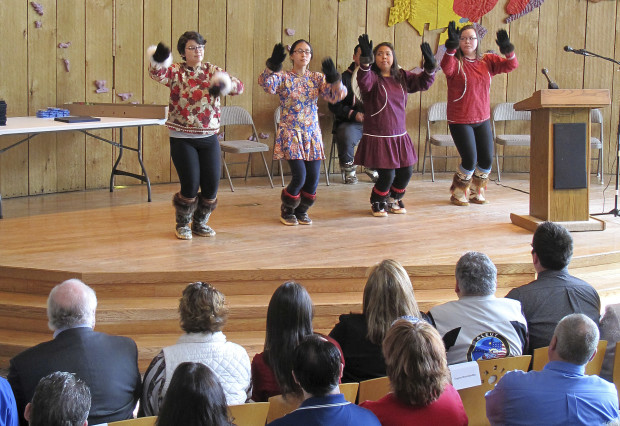
Cultural dancers perform at the Alaska Native Heritage Center, where Army honorary discharge papers were awarded to relatives of members of the Alaska Territorial Guard, a largely Native citizen militia that served to protect the U.S. territory from the threat of Japanese invasion during World War II, in Anchorage, Alaska, Friday, May 26, 2017. Relatives of 16 deceased members of the unit attended the ceremony at the Heritage Center to receive the posthumous honor. (AP Photo/Rachel D’Oro)
ANCHORAGE, Alaska — Officials on Friday posthumously honored more than a dozen members of a largely Native Alaskan citizen militia who protected the U.S. territory from the threat of Japanese invasion during World War II, bringing closure to their families for a service that went unrecognized for decades.
Gov. Bill Walker and state veterans affairs officials presented Army discharge papers to the relatives of 16 deceased members of the Alaska Territorial Guard during a ceremony ahead of Memorial Day weekend.
The event was an emotional time for Rebecca Czyz, the niece of militia member and Inupiat Eskimo sharpshooter Laura Beltz Wright, who was among just 23 women in the 6,400-member unit.
Czyz grew up with her aunt, who died in 1996. She said Wright was an adventurous woman who could outshoot most. She once ran mail by dog sled between villages and later owned a parka shop in Anchorage. She once told her niece that she would be fine with just a tent and a frying pan.
Czyz knew her aunt had served in the Territorial Guard but never paid much attention to that part of her life. She became more interested as she got older, and seeing the discharge papers gave her closure, Czyz said.
“I just felt very proud,” she said. “It would have been an honor for her to be here, but at least her family can accept this award for her.”
Alaska was still 17 years away from statehood when the militia formed in 1942 after Japan’s attack on Pearl Harbor and points along Alaska’s Aleutian Islands.
Nicknamed Uncle Sam’s Men and Eskimo Scouts, the volunteer members stepped in to watch over the 586,000-square-mile territory, which was vulnerable to further attack with the National Guard pressed into federal service. And they did it without pay.
The militia disbanded with little fanfare in 1947, almost two years after the war ended. But members were not formally recognized by the Army as military veterans until 2004.
Nearly 2,600 discharge papers have been issued since then by the Army, which has worked with the state Department of Veterans and Military Affairs to obtain the documents. Officials at Alaska Native Heritage Center in Anchorage plan to make the ceremony a yearly event as more papers are issued.
Mercedes Angerman, deputy director of the state military agency, said obtaining the discharge papers is a lengthy and sometimes challenging process.
Surviving relatives can have different last names than the Territorial Guard members. Sometimes families don’t realize their relative served in the unit or they don’t know the member’s date of birth, which is required.
“Sometimes it’s like catching the wind,” Angerman said.
She said the goal is to ultimately obtain a discharge for every member. Once families receive the documents, they qualify for a free headstone for the militia members from the National Cemetery Administration.